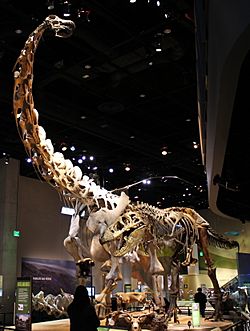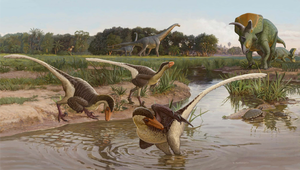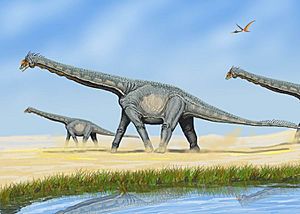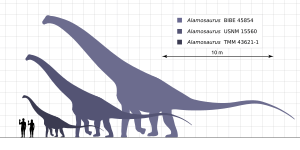Alamosaurus facts for kids
Quick facts for kids AlamosaurusTemporal range: Upper Cretaceous
|
|
|---|---|
 |
|
| Restored skeletons of Alamosaurus and Tyrannosaurus at Perot Museum | |
| Scientific classification | |
| Kingdom: | |
| Class: | |
| Superorder: | |
| Order: | |
| Suborder: | |
| Infraorder: | |
| Family: | |
| Subfamily: | |
| Genus: |
Alamosaurus
|
Alamosaurus was a titanosaur, a gigantic plant-eating dinosaur from the Upper Cretaceous period, about 73 million to 65 million years ago.
Alamosaurus was a long-necked, whip-tailed dinosaur. It was about 69 feet (21 m) long and weighed perhaps 33 tons (30000 kg). Fossils have been found in New Mexico, Texas, and Utah. Fossils include fragmentary skeletons (and no skulls).
Skeletal elements of Alamosaurus are among the most common Late Cretaceous dinosaur fossils found in the United States Southwest and are now used to define the fauna of that time and place. There was a climate change in this area, it became drier, and this caused changes in the fauna.
Skeletal elements of Alamosaurus are among the most common Late Cretaceous dinosaur fossils found in the United States Southwest and are now used to define the fauna of that time and place.
The appearance of Alamosaurus may have represented an immigration event from South America.
Naming
Contrary to popular assertions, this dinosaur is not named after the Alamo in San Antonio, Texas, or the battle that was fought there. The holotype, or original specimen, was discovered in New Mexico and, at the time of its naming, Alamosaurus had not yet been found in Texas.
Instead, the name Alamosaurus comes from Ojo Alamo, the geologic formation in which it was found. The term saurus is derived from saura, Greek for "lizard" and is the most common suffix used in dinosaur names.
There is one species (A. sanjuanensis), which is named after San Juan County, New Mexico, where the first remains were found. Both genus and species were named by Smithsonian paleontologist Charles W. Gilmore in 1922.
Anatomy
The vertebrae from the middle part of its tail had elongated centra. Alamosaurus had vertebral lateral fossae that resembled shallow depressions. Fossae that similarly resemble shallow depressions are known from Saltasaurus, Malawisaurus, Aeolosaurus, and Gondwanatitan. Venenosaurus also had depression-like fossae, but its "depressions" penetrated deeper into the vertebrae, were divided into two chambers, and extend farther into the vertebral columns.
Alamosaurus had more robust radii than Venenosaurus.
History of discovery
Alamosaurus remains have been discovered throughout the southwestern United States. The holotype was discovered in the Naashoibito Member of the Ojo Alamo Formation (or Kirtland Formation under a different definition) of New Mexico which was deposited during the Maastrichtian stage of the Late Cretaceous Period.
Bones have also been recovered from other Maastrichtian formations, like the North Horn Formation of Utah and the Black Peaks, El Picacho and Javelina Formations of Texas.
No skull material is known, except for a few slender teeth, and no armor scutes have been reported, such as those found in other advanced titanosaurians like Saltasaurus.
Paleoenvironment

Skeletal elements of Alamosaurus are among the most common Late Cretaceous dinosaur fossils found in the United States Southwest and are now used to define the fauna of that time and place, known as the "Alamosaurus fauna". In the south of Late Cretaceous North America, the transition from the Edmontonian to the Lancian faunal stages is even more dramatic than it was in the north. Thomas M. Lehman describes it as "the abrupt reemergence of a fauna with a superficially 'Jurassic' aspect. These faunas are dominated by Alamosaurus and feature abundant Quetzalcoatlus in Texas. The Alamosaurus-Quetzalcoatlus association probably represent semi-arid inland plains.
Images for kids
-
Restored Alamosaurus skeletal mount at the Perot Museum.
See also
 In Spanish: Alamosaurus sanjuanensis para niños
In Spanish: Alamosaurus sanjuanensis para niños







